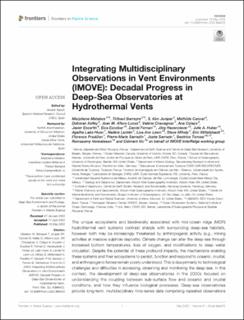| dc.description.abstract | The unique ecosystems and biodiversity associated with mid-ocean ridge (MOR) hydrothermal vent systems contrast sharply with surrounding deep-sea habitats, however both may be increasingly threatened by anthropogenic activity (e.g., mining activities at massive sulphide deposits). Climate change can alter the deep-sea through increased bottom temperatures, loss of oxygen, and modifications to deep water circulation. Despite the potential of these profound impacts, the mechanisms enabling these systems and their ecosystems to persist, function and respond to oceanic, crustal, and anthropogenic forces remain poorly understood. This is due primarily to technological challenges and difficulties in accessing, observing and monitoring the deep-sea. In this context, the development of deep-sea observatories in the 2000s focused on understanding the coupling between sub-surface flow and oceanic and crustal conditions, and how they influence biological processes. Deep-sea observatories provide long-term, multidisciplinary time-series data comprising repeated observations and sampling at temporal resolutions from seconds to decades, through a combination of cabled, wireless, remotely controlled, and autonomous measurement systems. The three existing vent observatories are located on the Juan de Fuca and Mid-Atlantic Ridges (Ocean Observing Initiative, Ocean Networks Canada and the European Multidisciplinary Seafloor and water column Observatory). These observatories promote stewardship by defining effective environmental monitoring including characterizing biological and environmental baseline states, discriminating changes from natural variations versus those from anthropogenic activities, and assessing degradation, resilience and recovery after disturbance. This highlights the potential of observatories as valuable tools for environmental impact assessment (EIA) in the context of climate change and other anthropogenic activities, primarily ocean mining. This paper provides a synthesis on scientific advancements enabled by the three observatories this last decade, and recommendations to support future studies through international collaboration and coordination. The proposed recommendations include: i) establishing common global scientific questions and identification of Essential Ocean Variables (EOVs) specific to MORs, ii) guidance towards the effective use of observatories to support and inform policies that can impact society, iii) strategies for observatory infrastructure development that will help standardize sensors, data formats and capabilities, and iv) future technology needs and common sampling approaches to answer today’s most urgent and timely questions. | en_US |

